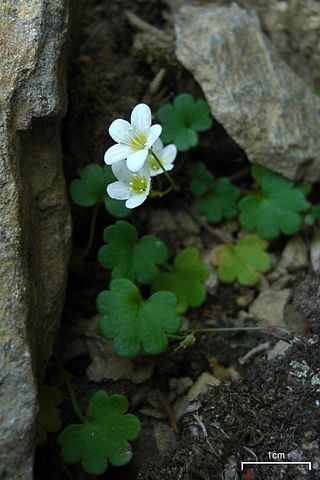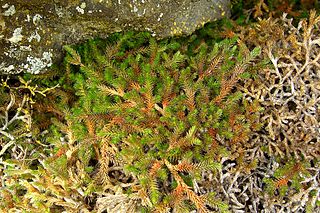
Lathyrus lanszwertii is a species of sweet pea known by the common names Nevada sweet pea or peavine. It is found in western North America from California to Texas to British Columbia. It is a tender vining perennial which bears lavender, fuchsia, or white pea flowers, and pods containing inedible peas. There is much variation among individuals of this species, and there are several distinct varieties:

Romanzoffia is a genus of flowering plants in the waterleaf family known as mistmaids or mistmaidens. There are 5 species which are native to western North America from California north to Alaska. Mistmaids may be annual or perennial and low patchy herbs to small bushes, depending on species. They bear attractive bell-shaped white flowers that make them desirable as ornamentals in the appropriate climates.

Clarkia gracilis is a species of wildflower known by the common name slender clarkia. This plant is native to the US states of California, Oregon, and Washington, where it is found in coastal, foothill, valley, and low-elevation mountain habitats. The plant is variable across subspecies but is generally an erect slender stem with a few sparse, narrow leaves several centimeters long. It bears an inflorescence of drooping buds which open into bowl-shaped flowers with pinkish lavender petals 1 to 4 centimeters long and bearing a red or white splotch which can appear in the center or at the base of the petal, depending on the subspecies.

Hemizonia congesta, known by the common name hayfield tarweed, is a species of flowering plant in the family Asteraceae, native to western North America.

Collomia tracyi is a species of flowering plant in the phlox family known by the common name Tracy's collomia. It is endemic to northern California, where it grows in the coniferous forests of the mountain ranges, including the Klamath Mountains. It is an annual herb producing a slender, branched stem no taller than about 8 centimeters. The glandular, hairy leaves are lance-shaped. The inflorescence is composed of two or three flowers emerging from the leaf axils. Each flower is white to lavender and up to 2 centimeters long. This species can be distinguished from the more common and widespread Collomia tinctoria by the positioning of the stamens and stigma in the flower.

Lomatium tracyi is a species of flowering plant in the carrot family known by the common name Tracy's desertparsley, or Tracy's lomatium. It is native to the mountains of northern California and southern Oregon, where it grows in the forests on the slopes, often on serpentine soils. It is a perennial herb growing up to 35 centimeters tall from a slender taproot. There is generally no stem, the leaves and inflorescence emerging at ground level. The leaf blades are divided and subdivided into a mass of overlapping threadlike to oval segments. The inflorescence is an umbel of yellow flowers.
Lupinus tracyi is a species of lupine known by the common name Tracy's lupine. It is endemic to the Klamath Mountains of southern Oregon and northern California, where it grows in coniferous forests. It is a perennial herb growing 20 to 70 centimeters tall and is mostly hairless in texture, with a thin, waxy stem. Each palmate leaf is made up of 6 or 7 leaflets measuring 1 to 4 centimeters in length. The inflorescence is a raceme of many flowers, sometimes arranged in whorls. The flower is around a centimeter long and is pale blue to whitish in color. The fruit is a hairy legume pod roughly 2 centimeters long which darkens as it dries.

Penstemon tracyi is a rare species of penstemon known by the common names Trinity penstemon and Tracy's beardtongue.

Plantago aristata is a species of plantain known by the common name bracted plantain or largebracted plantain. It is native to the eastern and central United States, and it can be found in other parts of North America as well as parts of Eurasia as an introduced species. It grows in many types of habitat, including disturbed areas, where it is a minor weed.

Raillardella argentea is a species of flowering plant in the family Asteraceae known by the common name silky raillardella. It is native to the Sierra Nevada and nearby mountain ranges of California, its distribution extending east into Nevada and north along the Cascade Range and Klamath Mountains into Oregon. It grows in many types of dry, open mountain habitat. It is a rhizomatous perennial herb growing in a clump of rosetted basal leaves. The leaves are lance-shaped, up to 8 centimeters long, and coated in silky hairs. The plant produces an inflorescence up to about 15 centimeters tall consisting of a solitary flower head which is cylindrical to somewhat bell-shaped. The head is enclosed in the fused outer scales of the flowers, which look similar to the phyllaries of many other species' flower heads. The head contains many yellow disc florets up to a centimeter long each, and no ray florets. The fruit is a long, narrow achene which may be 2 centimeters in length including its plumelike pappus.

Romanzoffia californica is a species of flowering plant in the borage family known by the common name California mistmaiden. It is native to Oregon and northern California, where it grows in moist and wet habitat, such as coastal bluffs and mountain forests.

Romanzoffia sitchensis is a species of flowering plant in the borage family known by the common name Sitka mistmaiden. It is native to western North America from Alaska through British Columbia and Alberta to far northern California and Montana.

Sagina apetala is a species of flowering plant in the family Caryophyllaceae known by the common names annual pearlwort and dwarf pearlwort. It is native to Europe and it is known elsewhere as an introduced species, including parts of North America. It grows in many types of disturbed habitat, such as cracks in the sidewalk. It is a petite annual herb producing a threadlike stem just a few centimeters long, spreading or growing erect. The plant is glandular and somewhat hairy. The leaves are linear in shape and not more than about a centimeter long. The inflorescence is a solitary flower borne on a threadlike pedicel. The flower has usually four sepals and generally no petals.

Sanicula tracyi is a species of flowering plant in the family Apiaceae known by the common names Tracy's blacksnakeroot and Tracy's sanicle. It is endemic to northwestern California, where it is known from woodlands and coniferous forest in hills and mountains. It is a perennial herb producing a slender stem up to about 60 centimeters tall from a taproot. The leaves are compound, divided into usually three leaflets which are deeply cut into lobes and serrated along the edges. The herbage is green to purple in color. The inflorescence is made up of one or more heads of bisexual and male-only flowers with tiny, curving, yellow petals. The fruits are 2 or 3 millimeters long, each fruit covered in bumpy tubercles and sometimes with prickles near the tip.

Saxifraga rivularis is a species of saxifrage known by several common names, including highland saxifrage, weak saxifrage, alpine brook saxifrage, and pygmy saxifrage.

Selaginella wallacei is a species of spikemoss known by the common name Wallace's spikemoss. It is native to western North America from British Columbia to California to Montana, where it can be found in many types of habitat, including open and shaded areas, and wet to dry environments, often growing on and over rocks. This lycophyte is variable in appearance, its form depending on the habitat it grows in. It can be spreading with many narrow branches, or a small, dense mat. The forking stems grow up to about 25 centimeters long, but may remain much shorter in dry conditions. They are lined with linear, lance-shaped, or oblong leaves up to 4 millimeters long including the bristles at the tips. The strobili containing the reproductive structures may be quite long, reaching up to 9 centimeters.

Silene noctiflora is a species of flowering plant in the family Caryophyllaceae known by the common names night-flowering catchfly, nightflowering silene and clammy cockle. It is native to Eurasia, but it is known on other continents as an introduced species and sometimes a weed. In North America, it is a common weed of grain crops in the Canadian prairie provinces and in much of the United States. It grows in fields and in other disturbed habitat.
Trifolium bifidum is a species of clover known by the common names notchleaf clover and pinole clover. It is native to the western United States from Washington to California, where it grows in many types of habitat. It is an annual herb spreading or growing erect in form. It is lightly hairy to hairless in texture. The leaves are made up of oval leaflets 1 to 2 centimeters long, usually with notches in the tips. The inflorescence is a head of flowers up to 1.5 centimeters wide. Each flower has a calyx of sepals that narrow to bristles covered in long hairs. The flower corolla is yellowish, pinkish, or purple and under a centimeter long. The flowers droop on the head as they age.
Agave phillipsiana is a rare species of flowering plant in the asparagus family known by the common names Grand Canyon century plant and Phillips agave. It is endemic to Arizona in the United States, where it lives only in Grand Canyon National Park. It is a perennial herb or shrub.
Erigeron tracyi is a North American species of flowering plant in the family Asteraceae known by the common name running fleabane. It is native to northern Mexico and the southwestern United States.















